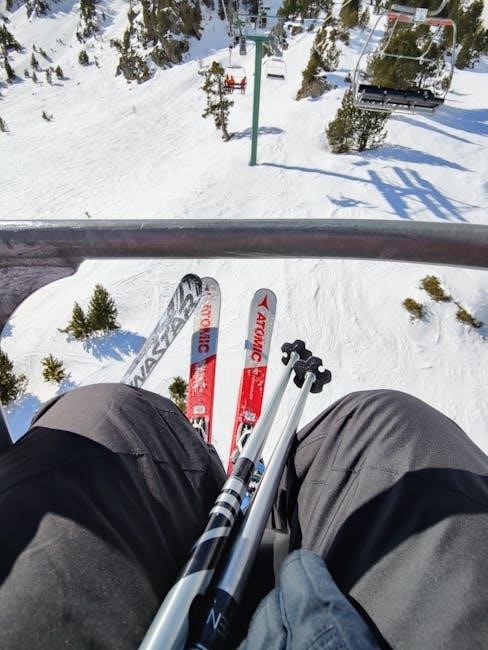ski boot buying guide
Understanding Fit and Comfort
A proper fit is crucial for performance and comfort. Boots should feel snug but not painful, allowing toe wiggle without heel lift. Poor fit can cause pressure points, blisters, or reduced control. A professional boot fitter can analyze foot shape, volume, and heel-to-ball measurement to ensure optimal comfort and support. Remember, boots break in over time, so a slightly tight fit may become perfect after use. Prioritize comfort and precision to enhance your skiing experience.
Importance of Boot Fit
A proper boot fit is essential for comfort, performance, and control on the slopes. Ill-fitting boots can lead to discomfort, blisters, or even cold feet, detracting from your skiing experience. A snug fit ensures precise control and responsiveness, allowing you to maneuver confidently. Poor fit can also cause fatigue, as your feet struggle to maintain proper positioning. Additionally, a well-fitting boot supports your ankle and foot, reducing the risk of injury. Prioritizing fit ensures that your boots function as intended, enhancing both performance and enjoyment. A professional boot fitter can help achieve this critical balance, making every ski day more enjoyable and effective.
Foot Shape and Volume Considerations
Foot shape and volume are critical factors in selecting ski boots. Boots must accommodate your foot’s width, instep height, and toe length for optimal comfort and performance. Narrow feet may require a tighter fit, while wider feet need a roomier boot to prevent pressure points. Volume refers to the overall space inside the boot, ensuring your foot isn’t cramped or swimming excessively. A proper fit balances snugness and freedom, avoiding blisters or restricted movement. Professional boot fitters use 3D foot analysis to match your foot shape with the right boot. This personalized approach ensures precision and comfort, maximizing control and enjoyment on the slopes.
Length, Width, and Volume Measurements
Accurate measurements are vital for a proper fit. Boot length should allow toes to wiggle slightly without heel lift. Width and volume must suit your foot’s shape to prevent discomfort. Narrower boots (92mm) suit competitive skiers, while medium widths (96-98mm) offer balance for most. Volume accounts for foot height and instep, ensuring space without excess. Mondo sizing charts help convert foot length to boot size. Professional fitters use these metrics to recommend boots, ensuring optimal performance and comfort. Proper measurements prevent blisters and enhance control, making every skiing experience enjoyable. Always try boots on and trust expert advice for the best fit.

Exploring Ski Boot Types
From all-mountain to freeride and touring boots, each type caters to specific skiing styles and preferences, ensuring optimal performance for various terrains and skiing techniques.
All-Mountain Ski Boots
All-mountain ski boots are designed for versatility, catering to skiers who explore various terrains, from groomed trails to off-piste conditions. These boots balance performance and comfort, offering a wide range of flex levels to suit different skiing styles and abilities. They typically feature moldable liners for a customizable fit and robust waterproofing to keep feet dry in snowy environments. Many models now include GripWalk soles for improved walking comfort and compatibility with modern bindings. Whether you’re carving on hardpack or venturing into fresh powder, all-mountain boots provide the adaptability and support needed for an enjoyable day on the slopes.
Freeride and Big Mountain Boots

Freeride and big mountain boots are built for adventurous skiers tackling challenging terrains like deep powder, steep lines, and rough backcountry. These boots emphasize durability and stability, often featuring stiff flex ratings for precise control at high speeds. They incorporate advanced materials for lightweight construction without compromising strength. Many models offer increased cuff mobility, allowing for efficient hiking and skinning when exploring remote areas. Waterproofing and superior insulation are standard, ensuring comfort in harsh conditions. If you’re seeking a boot that excels in demanding, unpredictable environments, freeride and big mountain boots deliver the performance and reliability needed for unforgettable descents and thrilling expeditions.
Touring and Backcountry Boots
Touring and backcountry boots are designed for skiers seeking lightweight performance in uphill and downhill adventures. These boots feature hike modes with exceptional cuff mobility for efficient skinning and climbing. They often incorporate carbon fiber and lightweight plastics to minimize weight without sacrificing strength. Many models include gaiter compatibility and waterproofing for protection in snowy and icy conditions. Touring boots also offer a comfortable fit for long days on the mountain, with features like moldable liners for customization. If you prioritize mobility and versatility for exploring remote terrain, touring and backcountry boots provide the perfect blend of uphill ease and downhill responsiveness, ensuring a seamless transition between traversing and descending.

Flex and Stiffness Guide
Flex rating indicates a boot’s stiffness, ranging from 80 (soft) to 130 (very stiff). Softer flex suits beginners, while stiffer boots are for advanced skiers needing precise control. Proper flex ensures optimal performance and comfort, adapting to skier ability and skiing style.
Understanding Flex Ratings
Flex ratings, typically ranging from 80 to 130, indicate a boot’s stiffness. Lower numbers (80-90) suit beginners, offering a softer feel for easier control. Medium ratings (100-110) balance support and flexibility, ideal for intermediate skiers. Higher ratings (115+) provide rigidity for advanced skiers, enhancing precision at high speeds. Flex is subjective and varies by brand, so trying boots on is crucial. Proper flex ensures optimal performance and comfort, aligning with skier ability and skiing style. A well-matched flex rating enhances control and reduces fatigue, making it a critical factor in boot selection.
Flex Numbers for Different Skier Levels
Flex numbers range from 80 to 130, catering to different skier levels. Beginners benefit from softer flex (80-90), offering easier control and comfort. Intermediate skiers thrive with medium flex (100-110), balancing support and responsiveness. Advanced skiers prefer stiffer flex (115+), delivering precision at high speeds. Weight and strength also influence flex needs, with lighter or less powerful skiers requiring softer boots. Proper flex alignment ensures optimal performance, comfort, and control, tailored to individual skiing styles and abilities. Always test boots to find the right flex for your skiing level and preferences.

Key Features to Consider
Key features include moldable liners for a precise fit, waterproofing for dryness, breathability for temperature regulation, GripWalk soles for binding compatibility, and customization options for personalization.
Moldable Liners and Customization
Moldable liners offer a tailored fit, reducing pressure points and enhancing comfort. These liners can be heat-molded to conform to your foot’s unique shape, improving performance and support. Customization options, like adjustable cuffs and canting, allow for a personalized fit, catering to various skiing styles and foot shapes. Many modern boots also feature removable and washable liners, ensuring long-term comfort and hygiene. Professional boot fitters often recommend moldable liners for their adaptability, making them ideal for skiers seeking a precise and comfortable fit. This customization ensures optimal control and responsiveness on the slopes, elevating your skiing experience.
Waterproofing and Breathability
Waterproofing and breathability are essential for keeping feet dry and comfortable. Premium ski boots feature waterproof membranes like Gore-Tex, ensuring moisture stays out while allowing sweat to escape. Breathable materials wick away perspiration, preventing blisters and cold feet. Proper ventilation prevents overheating, maintaining a stable internal climate. Look for boots with waterproof coatings and moisture-wicking liners to enhance comfort and performance. A balance of waterproofing and breathability ensures dry, warm feet, regardless of snow conditions or intensity of skiing. This combination is crucial for all-day comfort and optimal skiing performance, making it a key feature to prioritize when selecting your ski boots.
GripWalk Soles and Binding Compatibility
GripWalk soles offer enhanced traction for walking, making them ideal for skiers who need to move comfortably off the slopes. Designed with a more rugged tread pattern, these soles provide better grip on icy or uneven surfaces. However, compatibility with bindings is crucial, as not all bindings support GripWalk soles. Ensure your boots and bindings are compatible to maintain performance and safety. If your bindings are outdated, consider upgrading to models that support GripWalk technology; This feature is especially beneficial for skiers who value convenience and mobility. Always consult a professional to ensure proper setup and compatibility for optimal performance and safety on the mountain.

Buying Process Tips
Book in-store appointments with boot fitters, use Mondo sizing charts, and ensure proper fit. Consider flex, compatibility, and try boots on correctly for optimal performance and comfort.
Professional Boot Fitting Importance
Professional boot fitting ensures a precise and personalized fit, enhancing performance and comfort. Experts analyze foot shape, volume, and heel alignment to match the best boots. They address issues like pressure points and provide customization options, such as moldable liners. Proper fitting also extends boot lifespan by preventing wear and tear. Scheduling an appointment with a skilled boot fitter is highly recommended, especially for those with unique foot shapes or past fitting challenges. Their expertise guarantees a snug, supportive fit, allowing skiers to focus on their performance without discomfort or distractions on the slopes.
Using Mondo Sizing Charts
Mondo sizing charts are essential tools for determining boot size based on foot length. These charts convert foot measurements into boot sizes, varying slightly by brand and gender. While they provide a baseline, they don’t account for foot shape or volume. Proper sizing ensures optimal performance and comfort. Always try boots on, as Mondopoint sizing is just a starting point. Boot fitters use these charts alongside professional analysis to ensure the best fit. Remember, sizing can differ between brands, so relying solely on charts isn’t enough. Combine Mondo sizing with in-store trials for accurate results, ensuring your boots match your feet perfectly for peak performance.
Trying Boots On Properly
Trying boots on correctly ensures a precise fit. Visit a store in the afternoon, as feet swell during the day. Wear thin ski socks to replicate in-use conditions. Begin by slipping your foot into the boot without buckling it, ensuring your heel sits snugly at the back. Buckle the boot starting from the bottom, tightening progressively upward. Check for toe room—your toes should wiggle slightly without pressure. Stand up to assess the fit, ensuring the heel doesn’t lift excessively. Walk around to gauge comfort and support. Properly trying boots on helps identify potential issues and ensures a comfortable, performance-enhancing fit for skiing.

Boot Care and Maintenance
Regularly clean and dry boots to prevent damage. Condition materials to maintain flexibility. Store properly to avoid deformation. Check for wear and tear, and follow manufacturer guidelines.
Boot Durability and Lifespan
Quality ski boots typically last 200 skier days, but liners may lose shape sooner. Proper care, like drying and storing properly, extends lifespan. Boots with good fit and maintenance hold up better. Frequency of use, storage conditions, and handling impact durability. Even well-maintained boots may need replacement if soles wear down or liners become too packed out. Signs to replace boots include noticeable wear on soles, loose liners, or reduced performance; Regular inspections and professional fitting can help maximize lifespan and ensure optimal comfort and control on the slopes.
Boot Care and Maintenance Tips
Regular maintenance ensures your ski boots perform optimally. After use, allow boots to air dry completely to prevent mold and odor. Avoid extreme heat, as it can damage materials. Use waterproofing treatments on leather and fabric. For liners, hand wash with mild soap and air dry. Store boots in a cool, dry place, away from direct sunlight. Buckles and straps should be checked for wear and cleaned periodically. Applying a conditioning cream to leather parts can extend their lifespan. Following these tips helps maintain the structural integrity and comfort of your boots, ensuring they remain reliable season after season.
When to Replace Your Boots
Ski boots typically last around 200 skier days, but liners often lose shape and comfort sooner. If your boots feel too loose, the flex has softened, or the shell is damaged, it’s time to replace them. Look for signs like a packed-out liner, reduced responsiveness, or visible wear on the shell and soles. Additionally, if new technology or features could enhance your skiing experience, consider upgrading. Properly maintained boots can last longer, but neglecting replacement when needed can lead to poor performance and discomfort. Replace your boots when they no longer provide the support, precision, or durability you need for optimal skiing.

Expert Tips and Latest Tech
Advancements in ski boot technology focus on lightweight materials, improved flexibility, and enhanced customization. Carbon fiber shells, heat-moldable liners, and GripWalk soles are revolutionizing performance. Many boots now feature walk modes for better hiking comfort, while others prioritize sustainability with eco-friendly materials. Customizable options, like adjustable flex and boot fitting systems, cater to individual skiing styles. These innovations ensure better responsiveness, comfort, and durability, whether you’re carving groomers or exploring backcountry terrain. Staying updated on the latest tech can significantly elevate your skiing experience by providing superior support and control.
Expert Advice for Choosing Boots
Experts emphasize the importance of professional boot fitting to ensure optimal performance and comfort. They recommend trying on multiple boots, considering foot shape, volume, and skiing style. Flex rating should match your ability level, with softer flex for beginners and stiffer for advanced skiers. Customizable liners and adjustable features can enhance fit and responsiveness. Don’t overlook compatibility with bindings, especially for touring boots. Replace boots after 200 skier days or when liners pack out. Prioritize quality materials and construction for durability. Trusting a knowledgeable boot fitter can make a significant difference in your skiing experience, ensuring the perfect balance of comfort and control on the slopes.
Latest Technology in Ski Boots
Modern ski boots feature cutting-edge technology to enhance performance and comfort. Moldable liners and customizable shells provide a precise fit, while lightweight materials like carbon fiber reduce weight without sacrificing responsiveness. GripWalk soles improve compatibility with bindings and offer better traction. Advanced flex systems adapt to skiing conditions, offering optimal support and control. Heat-adjustable liners and intuitive closure systems further personalize the fit. Brands like Tecnica and Salomon incorporate innovative designs, such as the Zero G Peak, which excels in both uphill and downhill performance. These advancements ensure boots are more responsive, comfortable, and tailored to individual skiing needs, elevating the overall experience on the slopes.
